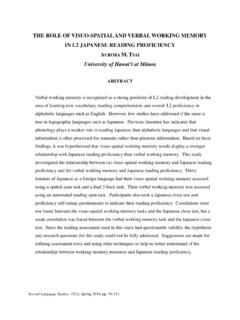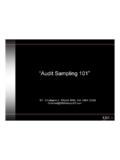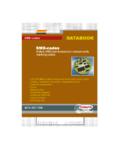Transcription of Measuring Abundance: Transects and Quadrats
1 Measuring abundance : Transects and Quadrats Concepts: estimation, percentage, error and zonation Modified by Joanna Philippoff and Erin Cox from lessons developed by Erin Baumgartner and Chela Zabin Introduction: Transects and Quadrats are two ecological tools that allow us to quantify the relative abundance of organisms in an area. To track changes over time, it is important to be able to quantify changes in abundance . Also, learning these techniques will give students the tools necessary to ask their own ecological questions and make comparisons among sites. A transect line is any line, marked at regular intervals, that is easy to use in the field. Transect lines can be purchased commercially, made from Measuring tape or rope marked off at regular intervals. A quadrat is a framed area. A frame can be made using PVC pipes, wire hangers bent into squares, hula-hoops, wooden dowels or even cardboard. Use monofilament or string to section off the quadrat into a set number of squares or intercepts.
2 Point-intercept along a transect line: The simplest ecological sampling method is point intercept. You can lay the transect line across the classroom and record what is directly under each meter or half meter mark on the line ( table, floor, backpack, book, pencil, student). This technique is good for sampling a very large area relatively quickly, but as students often point out, it can miss a lot of information if the area is complex. The use of Quadrats can help achieve additional levels of complexity. Visual estimate within a quadrat: Place a quadrat along pre-determined points along a transect line and have students estimate and record what percent each item takes up within the frame ( 75% species A, 25% species B). The quadrat divisions can also be used to estimate what is in each of the smaller squares ( 12 squares species A, 5 squares species B, squares species C, etc.). Organisms that take up very little area can be recorded as <1% or < squares. Point-intercept within the quadrat: Place a quadrat with intersecting lines along pre-determined points on the transect line (usually the same points as used for the visual estimate) and record what is underneath each intersection within the quadrat frame.
3 This method is similar to that used on the transect, but there are multiple intersections within the square frame to be counted. Photoquadrats: Students can compare the two quadrat methods by using photo Quadrats : photographs of an area from the study site sized to fit the quadrat frame. By trying the techniques within the classroom setting, they have a chance to practice and ask questions about how to employ the techniques. This also allows the students to practice identifying the organisms they will find at the study site using ID cards or reference books in the classroom. Sample Lesson to Introduce Transects and Quadrats : Sweet Species One way to introduce Transects and Quadrats is through the use of candy sweet species . Buy an assortment of candy (or cut up different colored index cards), of various sizes and shapes, to represent different species at your monitoring site. This activity works best if the sweet species are substantial in size or grouped in snack bags that candy companies sell at Halloween.
4 Small candy will be hard to monitor, just as small species in the field are harder to monitor. Throw the candy on the classroom floor and ask the students how they would go about monitoring the species in their classroom study site. Learning How to Lay Transects : Divide the class into groups and give each group a transect. Without giving any additional information, ask each group to lay out their transect in a location to best monitor the sweet species. You will most likely get a spider-web of Transects laid out over the study site. Point out that where Transects cross, organisms or candy at the intersections will be recorded multiple times, falsely increasing their perceived abundance . To prevent this, the Transects should be laid parallel to each other (an equal distance apart). Special considerations at your study site will determine how you place the Transects in the field. For instance, in the intertidal some species cluster in the high intertidal while others cluster in the low intertidal, creating different ecological zones that lie in bands along the coast.
5 This means we need to lay our Transects perpendicular to the shoreline to stratify our samples and sample appropriately across all the spatial scales of the intertidal. You can demonstrate the concept of stratified sampling by using different colors of jellybeans layered in a clear jar. If your class were to sample jellybeans from the jar the same way the students sampled in the Jellybean Lesson, they would miss the species towards the bottom of the jar and overestimate the abundance of species on the top. Laying the Transects perpendicularly in the intertidal is analogous to laying a transect through the jar of jellybeans, allowing us to sample from all the species layers . You can replicate this with your sweet species in your classroom. Determine where the beach and deep ocean lie in relation to your classroom study site and place different candy species in different bands or zones parallel to your classroom coastline. In the field, some intertidal species are present in many or all of the different intertidal zones, while others favor either the high or low intertidal.
6 Some other things to standardize when learning to lay Transects that you can have your students discuss: 0 marks on Transects should all be in same direction (into water, so turning mechanism of transect lays out of water to prolong life of transect) Transects should all have the same side of the tape facing up (scientists, and thus OPIHI, follow the metric system). Demonstrating the Methods: Have two students go along one of the Transects . Record what is under each meter or half meter (depending on the size of your classroom) on a table everyone can see. Since your class is omnipotent and can see all the sweet species at their study site, your students can answer a lot of questions that would be impossible to answer in the field where the species will be a little more camouflaged. Did we get all of the organisms that are in the intertidal? Look around are some organisms more common than others? Do you think the data from our transect reflects this?
7 Using Quadrats may solve some of the problems that occur when just using a transect. As a class, decide where to place the quadrat in relation to the transect. It should not matter where the quadrat is placed as long as the placement is the same each time among all the groups. For instance, always place the quadrat right over the transect point, which is easy to remember although the transect tape might obscure some organisms, or always place the ( bottom left) corner of the quadrat over the transect point. Practice once as a class with two volunteers using both quadrat methods and recording the results on the board before having all the groups try both the transect and each quadrat method to monitor the sweet species. Tricky Sweet Species: Try to include two candies of the same shape, such as traditional silver Hershey kisses and purple colored dark chocolate kisses, or use both light and dark pink colored paper cards in the same shape. When recording species you can ask the students if purple kisses are the same species as silver kisses, or are if they are the males and females of the same species.
8 As long as the class agrees and records the data in the same way, it does not matter how many species the candy represents. This is true in the class or in the field. Practice makes Perfect: Courtyard Sampling The next step is to have students practice all of the techniques in a relatively simple area, such as the school lawn or garden. Have the class decide the best way to lay the Transects , determine how long they should be, and how often they should sample (ie. every meter or half meter) to most accurately monitor the site. Students should determine how specific their designations will be as a class before starting the activity so everyone records the same type of data. For instance will they differentiate between dirt and sand? Different types of grasses? Ask what would happen it they didn t decide on these guidelines before monitoring an area. As they try out each technique they can reflect on how each technique works in this setting, and think about how best to use them alone or in combination to accurately and efficiently gain the most information about an area.
9 They may consider which techniques might be best to use in different kinds of areas. Finally, they can plan which technique or combination of techniques they might use to quantify an area, and then employ their plan in the field. Lastly, before you go on your first monitoring field trip, it is helpful to practice the quadrat methods on photoquadrats, life-sized photographs sizes to fit the dimensions of your class s Quadrats . This is especially important if you are monitoring an environment where students may be unfamiliar with many of the organisms they will encounter, such as the intertidal. Photoquadrats allow students to practice their quadrat methodology and species identification skills. As with the courtyard sampling, students can reflect on how well each quadrat sampling method works at capturing the organisms in the photographs. See the Photoquadrat lesson for more details. Questioning Strategies: How could we figure out how large the population of a species is in an area?
10 Counting, or making a list of species, but if there is a lot of something that may take a very long time. We could estimate, but there should be a methodical way to do so -- such as sampling. What are the limitations of a list of species? We won t know how many of each species. We could count and identify all of the species - but what if there is a lot of one species in an area? Or what about colonial species, like sponges, or species where it is difficult to determine what an individual organism is, as in some algal species? What is the meaning of one sponge? Is one tiny sponge the same as one huge sponge? What is monitoring? What do we need to know at a site to monitor it? Monitoring is seeing how things change with time. To monitor a site we need to know the number of species at a site and species abundance , or how many of each species are present. If we always use the same methods to monitor a site, we can not only track changes in species over time but be able to compare different sites as long as both locations were monitored the same way.











